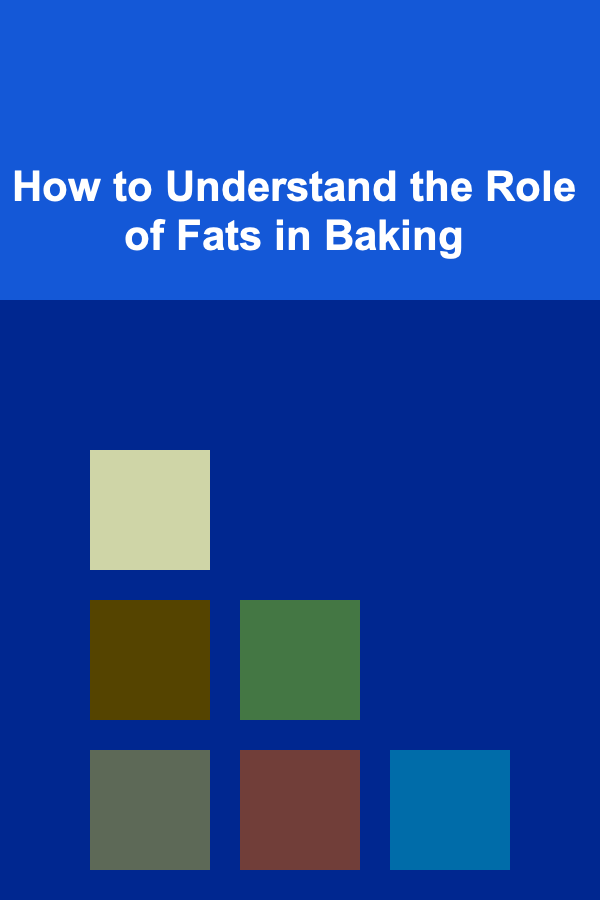
How to Understand the Role of Fats in Baking
ebook include PDF & Audio bundle (Micro Guide)
$12.99$10.99
Limited Time Offer! Order within the next:

Baking is both an art and a science, where each ingredient plays a crucial role in achieving the desired outcome. Among the most significant ingredients is fat, which is often misunderstood or overlooked in terms of its vital role in baking. Whether it's butter, oil, or shortening, fats contribute to texture, flavor, and even the color of baked goods. In this article, we will delve into the importance of fats in baking, explaining how they function, the different types of fats, and how they affect the structure and sensory qualities of the final product.
The Role of Fats in Baking
Fats are essential in baking for several reasons, and they affect the texture, flavor, color, and overall quality of the final product. In general, fats are used to:
1.1. Provide Tenderness
Fats create a tender texture in baked goods by coating the flour particles, which prevents the formation of long gluten strands. Gluten is a protein that develops when flour is mixed with liquid, and it provides structure to dough. When fat is added, it interferes with gluten development, resulting in a more delicate and tender crumb. This is especially important in recipes like cakes, pastries, and cookies, where a light, soft texture is desired.
For example, when making a cake batter, the fat---often in the form of butter or oil---helps prevent the formation of too much gluten, ensuring the cake has a soft, moist crumb instead of being tough and dense.
1.2. Contribute to Flakiness
In certain baked goods, particularly in pastries like croissants, puff pastry, and pie crusts, fats are responsible for the flakiness of the final product. The fat is layered into the dough through a process called lamination, where the dough and fat are folded and rolled multiple times to create thin layers. When baked, the fat melts, creating pockets of air that expand and create a light, flaky texture.
Butter, in particular, is often preferred for this purpose because it contains water in addition to fat, which helps create steam during baking and further enhances the flakiness of the product.
1.3. Add Flavor
Fat is a carrier of flavor, and its presence in baked goods can enhance and intensify the overall taste. Butter is a classic example of fat that imparts a rich, creamy flavor to cookies, cakes, and other baked goods. The flavor of fat is especially important in recipes where the fat is the primary flavor contributor, such as in shortbread cookies, where butter is the star ingredient.
Different fats contribute distinct flavors, and the choice of fat can significantly influence the final taste of the product. For instance, vegetable oils may provide a neutral flavor, while coconut oil offers a subtle coconut flavor, and lard provides a unique, savory richness.
1.4. Influence Moisture Content
Fats also play a crucial role in retaining moisture in baked goods. The fat molecules trap water during the mixing process, helping to keep the product moist and extending its shelf life. This is particularly important in cakes and muffins, where a dry texture can quickly turn an otherwise delicious treat into something unappealing.
Oil, being liquid at room temperature, is particularly effective at helping to retain moisture and produce a soft, moist crumb in cakes. In contrast, butter, which solidifies at room temperature, may result in a slightly firmer texture.
1.5. Enhance the Color and Crust
Fat contributes to the golden-brown color of baked goods, particularly in the crust. As the fat melts during baking, it helps to caramelize the sugars in the dough, resulting in a beautifully golden crust. The Maillard reaction, a chemical process that occurs when proteins and sugars react under heat, is also enhanced by the presence of fat, giving baked goods a rich, appealing color.
This is why butter, with its golden hue, is often preferred in recipes where color and appearance are important, such as in cookies, cakes, and bread.
Different Types of Fats Used in Baking
There are various types of fats used in baking, each with its characteristics, benefits, and effects on the final product. Let's take a closer look at the most common types of fats used in baking.
2.1. Butter
Butter is perhaps the most beloved fat in baking, thanks to its rich flavor, tenderizing properties, and ability to create flakiness in certain pastries. It is made by churning cream to separate the fat from the liquid, and it contains about 80% fat and 20% water. The water content in butter helps create steam during baking, which enhances the texture and contributes to the flakiness of baked goods like pie crusts and croissants.
Butter's flavor is also a key factor in its popularity. It imparts a creamy, slightly sweet flavor that complements many baked goods. However, because of its water content, butter has a lower fat content than some other fats, which means it may not always be the best choice for certain baking applications, such as in recipes that require a very high-fat content.
2.2. Vegetable Oil
Vegetable oils, including canola oil, sunflower oil, and safflower oil, are commonly used in baking for their neutral flavor and ability to create a moist crumb. These oils are 100% fat and lack the water content found in butter, which means they do not contribute to flakiness in pastries. However, because they are liquid at room temperature, they help retain moisture in cakes, muffins, and other baked goods.
Oil-based cakes, such as carrot cake and chocolate cake, often turn out incredibly moist and tender due to the high fat content provided by the oil. Additionally, vegetable oils are typically less expensive than butter, making them a popular choice for large-scale baking.
2.3. Shortening
Shortening is a solid fat made from vegetable oils that have been chemically processed to turn them into a solid form at room temperature. Like butter, shortening is often used in recipes that require a tender, flaky texture, such as pie crusts, cookies, and pastries. Shortening has a higher melting point than butter, which helps it hold its shape better during mixing and baking, making it ideal for creating flaky layers in dough.
However, shortening has a more neutral flavor compared to butter, so it may not contribute the same richness and depth of flavor. It also lacks the natural dairy flavor found in butter, which is why it is often blended with other fats or ingredients to enhance the flavor profile.
2.4. Lard
Lard is rendered pork fat, and it has been a traditional fat used in baking for centuries. It has a high fat content and produces a very tender and flaky texture in baked goods like pie crusts and biscuits. Lard is often praised for its ability to create a flaky, crisp texture, and many bakers still swear by its use in pie crusts, claiming it yields a superior result compared to butter or shortening.
While lard is highly effective in terms of texture, it has a distinct savory flavor that may not be suitable for all baked goods. Its use has declined in recent years due to health concerns related to saturated fats, but it is still favored in certain traditional recipes.
2.5. Margarine
Margarine is a spread made from vegetable oils that have been processed to mimic the properties of butter. It has a similar texture to butter and can be used as a substitute in many baking recipes. Margarine is often less expensive than butter and can be found in various forms, from sticks to tubs.
While margarine can work well in some baked goods, it may not provide the same rich flavor that butter does. It is also worth noting that some margarine products contain trans fats, which can have negative health effects, so it's important to choose trans fat-free margarine when using it in baking.
How Fats Affect Different Types of Baked Goods
The type and amount of fat used in baking can have a profound effect on the texture, flavor, and appearance of different types of baked goods. Let's explore how fats affect specific categories of baked goods.
3.1. Cakes
In cakes, fats contribute to a tender crumb and a moist texture. The fat helps to coat the flour particles, preventing too much gluten from forming and resulting in a light, fluffy texture. Butter is often preferred for its flavor, but oil can also be used in cakes for a moist, tender crumb. The key to a successful cake lies in balancing the right amount of fat with the other ingredients.
3.2. Cookies
In cookies, the fat helps to control the spread of the dough during baking, contributing to the texture and shape of the final product. Butter or shortening is commonly used in cookies, as these fats create a chewy or crispy texture depending on the recipe. The choice of fat will also affect the flavor of the cookies, with butter providing a rich, creamy taste, while shortening offers a more neutral flavor.
3.3. Pastries and Pie Crusts
Fats are critical in creating the flaky texture of pastries and pie crusts. In these recipes, the fat is cut into the flour to form small, pea-sized pieces that melt during baking, creating layers and pockets of air. Butter, shortening, or lard are often used to create the desired flakiness, and the ratio of fat to flour is essential in determining the final texture.
3.4. Bread
In bread-making, fats help to create a soft, tender crumb while also improving the bread's shelf life. Fat acts as a barrier to moisture loss, preventing the bread from drying out too quickly. However, not all bread recipes require a large amount of fat; lean bread doughs, like baguettes, rely primarily on flour, water, yeast, and salt, with only small amounts of fat added to the dough for tenderness.
Conclusion
Fats play a multifaceted role in baking, influencing texture, flavor, color, and moisture retention in baked goods. By understanding the science behind how fats work in baking, you can make informed choices about which fats to use in your recipes. Whether you're aiming for a flaky pie crust, a tender cake, or a rich batch of cookies, the right fat can make all the difference in achieving the perfect baked treat.
Choosing the right fat for each baking application is an art that takes practice and experimentation. With an understanding of how fats function in baking, you'll be able to fine-tune your recipes and create delicious baked goods that are both flavorful and visually appealing.

Building a Support System During Your Job Search: An Actionable Guide
Read More
How to Install Energy-Efficient Appliances During a Renovation
Read More
How to Use Drawer Dividers for a Neat Kitchen
Read More
How to Use Landscaping to Improve Home Security
Read More
How to Build a DIY Solar Charger
Read More
10 Tips for Planning Food Videography: Lighting & Styling
Read MoreOther Products

Building a Support System During Your Job Search: An Actionable Guide
Read More
How to Install Energy-Efficient Appliances During a Renovation
Read More
How to Use Drawer Dividers for a Neat Kitchen
Read More
How to Use Landscaping to Improve Home Security
Read More
How to Build a DIY Solar Charger
Read More